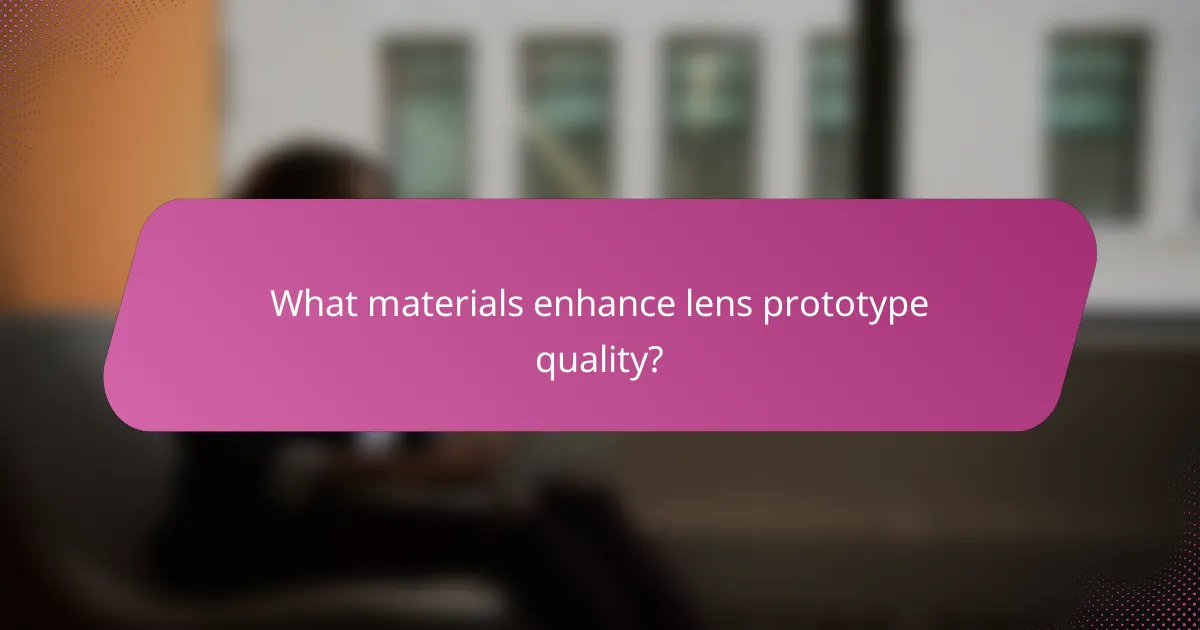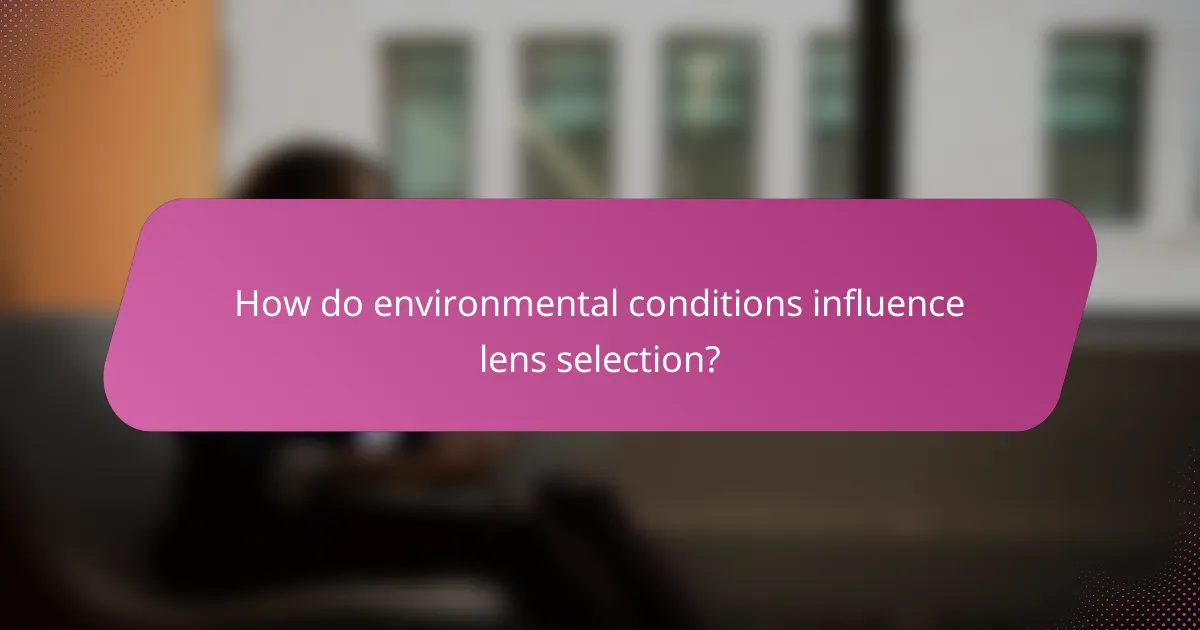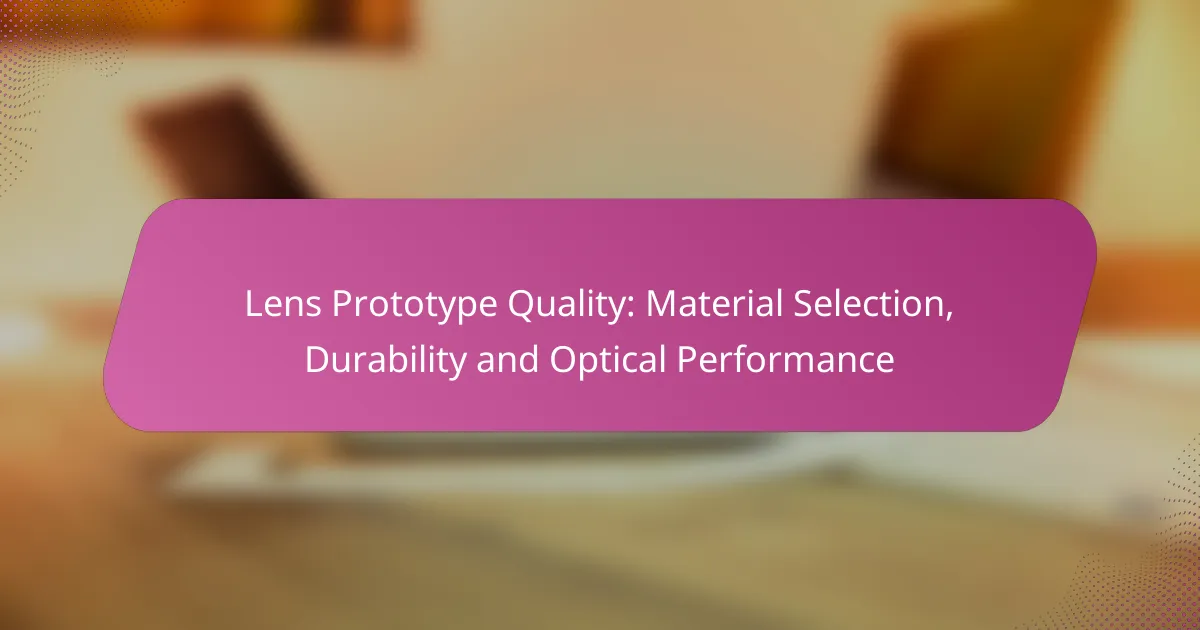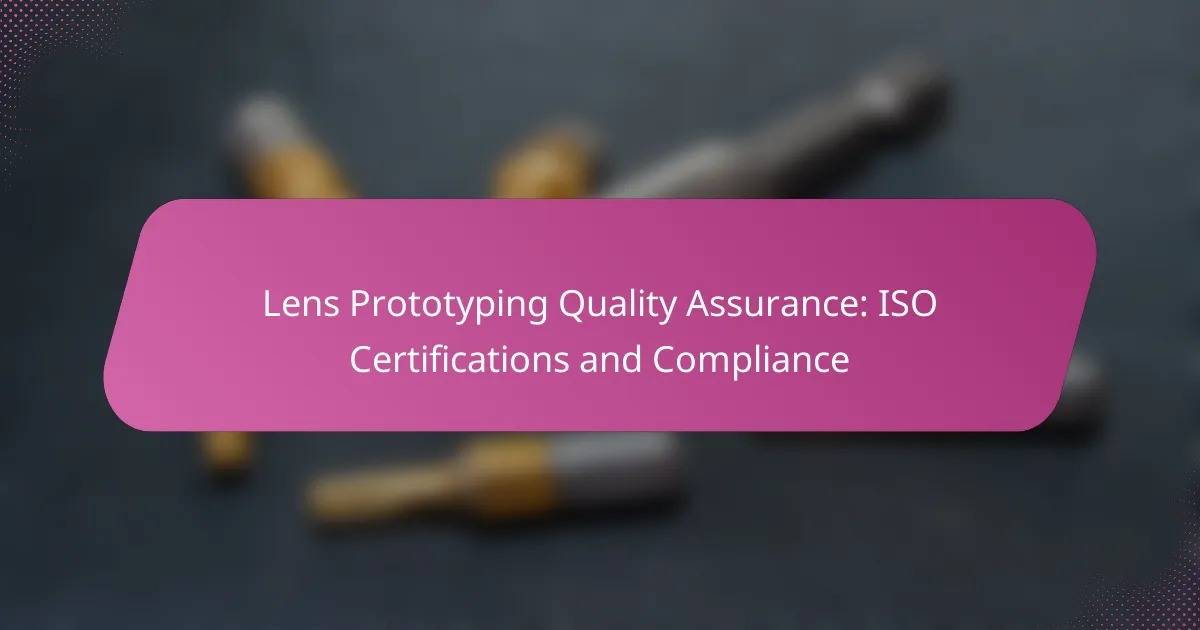In the development of lens prototypes, the selection of materials is vital for optimizing durability, weight, and optical performance. The right materials not only enhance the lifespan of the lenses but also significantly improve their functionality and user experience. Key factors such as refractive index, surface coatings, and aspheric designs are essential in achieving superior optical performance, ensuring that lenses effectively focus light and minimize visual distortions.

What materials enhance lens prototype quality?
Materials play a crucial role in enhancing lens prototype quality by affecting durability, weight, and optical performance. Selecting the right material can significantly improve the overall functionality and user experience of the lenses.
Polycarbonate for impact resistance
Polycarbonate is known for its exceptional impact resistance, making it an ideal choice for safety glasses and sports eyewear. This lightweight material can withstand high levels of force without shattering, which is essential in environments where lens durability is critical.
When choosing polycarbonate lenses, consider their ability to block UV rays, providing additional eye protection. However, they may scratch more easily than other materials, so applying a scratch-resistant coating is advisable.
CR-39 for lightweight performance
CR-39 is a popular plastic lens material that offers a good balance between weight and optical clarity. It is significantly lighter than glass, making it comfortable for prolonged wear, especially in prescription eyewear.
This material also provides decent impact resistance and is less expensive than high-index plastics. However, it is thicker than some alternatives, which may be a consideration for those seeking ultra-thin lenses.
High-index plastics for thinner designs
High-index plastics are designed for those who require stronger prescriptions while still wanting a lightweight and thin lens. These materials can reduce lens thickness by up to 50% compared to standard plastic lenses, enhancing comfort and aesthetics.
While high-index lenses are more expensive, they offer excellent optical performance and reduced distortion. It’s essential to weigh the cost against the benefits, especially for higher prescriptions where thickness can be a concern.
Glass for superior optical clarity
Glass lenses are renowned for their superior optical clarity and scratch resistance, making them a premium choice for high-quality eyewear. They provide excellent visual acuity, which is particularly beneficial for those who prioritize clear vision.
However, glass lenses are heavier and more prone to shattering than plastic alternatives. They are less commonly used in safety eyewear but remain popular in fashion and high-end optical markets.
Trivex for safety and comfort
Trivex is a relatively new lens material that combines the best features of polycarbonate and CR-39. It offers excellent impact resistance, making it suitable for safety glasses, while also being lightweight and providing good optical clarity.
This material is particularly advantageous for those needing durable yet comfortable lenses. Trivex lenses can be a bit pricier than standard options, but their performance in both safety and comfort makes them a worthwhile investment for many users.

How does material selection affect durability?
Material selection significantly impacts the durability of lenses by determining their resistance to physical damage, environmental factors, and wear over time. Choosing the right material can enhance the lifespan and performance of optical products, making it essential for manufacturers and consumers alike.
Impact resistance of polycarbonate
Polycarbonate is known for its exceptional impact resistance, making it a popular choice for safety glasses and sports eyewear. It can withstand high levels of force without shattering, which is crucial in environments where lens breakage could pose safety risks.
When selecting polycarbonate lenses, consider their thickness and coating options. Thicker lenses generally offer better protection, while anti-scratch coatings can enhance their longevity. However, polycarbonate lenses may be more prone to scratching compared to glass, so balancing these factors is important.
Scratch resistance of glass
Glass lenses are renowned for their scratch resistance, providing a clear advantage in maintaining optical clarity over time. They are less likely to show wear from everyday use, making them ideal for individuals who prioritize visual quality and durability.
However, glass lenses are heavier and more fragile than their plastic counterparts, which can lead to breakage upon impact. For those who choose glass, it’s advisable to use protective cases and avoid dropping them to maximize their lifespan.
Weather resistance of high-index plastics
High-index plastics offer a balance between lightweight design and weather resistance, making them suitable for various environmental conditions. These materials are often treated to resist UV light and moisture, which can enhance their durability in outdoor settings.
When selecting high-index plastic lenses, check for additional coatings that can improve resistance to fogging and environmental damage. While they may not be as impact-resistant as polycarbonate, their lightweight nature and optical performance make them a popular choice for everyday eyewear.

What are the key factors in optical performance?
The key factors in optical performance include the refractive index of lens materials, surface coatings for glare reduction, and aspheric designs that enhance vision. Each of these elements plays a crucial role in determining how effectively a lens can focus light and reduce visual distortions.
Refractive index of lens materials
The refractive index measures how much light bends when it enters a lens material. Higher refractive indices allow for thinner lenses while maintaining optical performance, which is particularly beneficial for strong prescriptions. Common materials like polycarbonate and high-index plastics offer refractive indices ranging from about 1.50 to 1.74.
When selecting lens materials, consider the trade-off between weight and optical clarity. While higher-index lenses can be thinner, they may also be more prone to scratches unless treated with protective coatings.
Surface coatings for glare reduction
Surface coatings significantly enhance the optical performance of lenses by reducing glare and reflections. Anti-reflective (AR) coatings are particularly popular, as they minimize light loss and improve clarity, especially in low-light conditions. These coatings can increase visual comfort and reduce eye strain.
When choosing coatings, look for options that also provide scratch resistance and UV protection. A quality AR coating can enhance the overall experience, particularly for those who spend extended periods in front of screens or driving at night.
Aspheric designs for improved vision
Aspheric lens designs feature a non-spherical shape that helps reduce distortion and improve peripheral vision. Unlike traditional spherical lenses, aspheric lenses can provide a wider field of view and better clarity, especially for higher prescriptions.
Consider aspheric designs if you require strong prescriptions or want to minimize lens thickness. While they may come at a higher cost, the improved optical performance and comfort can be well worth the investment.

How do environmental conditions influence lens selection?
Environmental conditions significantly impact lens selection by dictating the materials and coatings that enhance performance and durability. Factors such as UV exposure, humidity, and temperature variations must be considered to ensure optimal optical performance and longevity.
UV protection in outdoor lenses
UV protection is crucial for outdoor lenses, as prolonged exposure to ultraviolet rays can lead to eye damage. Lenses should ideally block 99% to 100% of UVA and UVB rays, which is typically achieved through specialized coatings or materials.
When selecting outdoor lenses, look for those that meet ANSI Z80.3 standards for UV protection. Polarized lenses can also reduce glare, enhancing visual comfort and clarity in bright conditions.
Anti-fog coatings for humid environments
Anti-fog coatings are essential for lenses used in humid environments, as moisture can obscure vision. These coatings work by reducing surface tension, preventing water droplets from forming on the lens.
For optimal performance, choose lenses with permanent anti-fog treatments rather than temporary sprays, which may wear off quickly. Regular maintenance, such as cleaning with appropriate solutions, can help maintain the effectiveness of these coatings.

What are the best practices for lens prototype testing?
Best practices for lens prototype testing involve a systematic approach to evaluate optical performance, durability, and material selection. Prioritizing these aspects ensures that the final product meets quality standards and user expectations.
Optical performance assessments
Optical performance assessments focus on measuring how well a lens transmits light and resolves images. Key metrics include resolution, contrast, and distortion. Testing methods often involve using optical benches and specialized software to analyze the lens’s performance under various conditions.
Common tests include MTF (Modulation Transfer Function) analysis, which quantifies the lens’s ability to reproduce detail, and chromatic aberration tests that evaluate color fidelity. These assessments should be conducted in controlled environments to ensure accuracy.
Durability testing methods
Durability testing methods evaluate how well a lens withstands physical stress and environmental factors. This includes impact resistance tests, where lenses are subjected to drops or impacts to assess breakage and deformation. Additionally, exposure to extreme temperatures and humidity can help determine material resilience.
Common practices include the use of standardized tests such as ASTM or ISO protocols, which provide guidelines for evaluating lens durability. It’s crucial to document results meticulously to identify weaknesses and improve future prototypes.

What trends are shaping lens material innovations?
Current trends in lens material innovations focus on enhancing sustainability, durability, and optical performance. Manufacturers are increasingly exploring advanced materials that not only meet consumer demands for quality but also address environmental concerns.
Biodegradable lens materials
Biodegradable lens materials are becoming a significant trend in the eyewear industry, driven by the need for sustainable alternatives to traditional plastics. These materials, often derived from natural sources, can break down over time, reducing environmental impact.
Common biodegradable options include polylactic acid (PLA) and cellulose acetate. When selecting biodegradable lenses, consider their durability and performance under various conditions, as some may not offer the same longevity as conventional materials.
To ensure optimal performance, look for brands that provide clear information on the lifespan and disposal methods of biodegradable lenses. Avoid lenses that lack certification or transparency regarding their environmental claims, as this can lead to misleading expectations.



